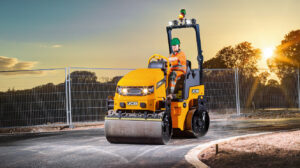
JCB re-enters North American paving market
By Adam Freill
Construction EquipmentEquipment manufacturer introduces a pair of small, high efficiency compaction machines, the CT160 and CT260.
With the introduction of two new tandem roller compaction machines to the North American market, JCB is once again active in the North American paving market. The company says its CT160 and CT260 models are designed for ease of use, all day productivity, low maintenance and operator comfort.
“We are re-entering the North American market with a strong, proven product,” said James Gill, product manager for backhoe loaders, site dumper and compaction equipment at JCB North America. “The models have been available in markets outside of North America for some time. They have proven to be a great success, and the durability has been truly tried and tested.”
The machines will be branded “Vibromax,” after the German company JCB acquired in 2005.
“The Vibromax was a well-respected product, with the North American arm of the original company being based out of Racine, Wisconsin,” explained Gill. The JCB Vibromax soil compaction machinery line is used globally, and JCB says it has put all the engineering expertise acquired from Vibromax into the development of these new compaction products.
“By re-entering the North American market with a product that we have confidence in, it paves the way for the rollout of an extensive portfolio of compaction equipment,” added Gill.
The CT160 offers a choice of either a 31.5” (800 mm) or a 39.3” (1000 mm) drum. The CT260 comes with a 47.2” (1200 mm) drum. Both machines provide contractors with high precision and high uptime compaction operations, and weigh in at 3,770 to 6,041 pounds, making them easily trailered.
Both machines feature a responsive directional drive lever designed to enable smooth fore and aft movements. From a bird’s eye view the CT160 and CT260 have an hourglass profile, which enables operators to clearly see the drum edges. On the CTs’ control panels, work modes are easy to understand, and the switches are sized to create positive tactile feedback even with gloved hands. Anti-vibration mounts are engineered to reduce fatigue by isolating the operator from the drum vibrations.
Automatic vibration control is standard, and the CT160 and CT260 feature three vibration settings: vibration for both drums; vibration for the rear drum only; or vibration for the front drum only.
The manually adjustable offset on the front drum enables the operator to avoid damage to curbs and ironwork. The rear drum is flush with the rear chassis so operators can work close to walls or obstacles. Chamfered edges on the drums deliver a smooth finish, and a pressurized water spray system keeps the drums clean during operation. The drum scraper bars, two per drum, are also easy to adjust whether working with stone or asphalt, says the company.
All engine service points are accessible at ground level, and a high lift, tilt up engine hood gives operators easy access to all daily maintenance checks. Fuel efficient engines power both models. The
CT160 uses a three cylinder, 19.8 hp engine, and the CT260 models get a three cylinder, 24.4 hp engine. All engines are Tier4 Final compliant and do not require a diesel particular filter (DPF) or diesel exhaust fluid (DEF/Ad Blue).
JCB’s LiveLink telematics system is standard, providing customers with real-time location and geofencing, utilization monitoring and operational data, including when the vibration system is in use. Additionally, JCB LiveLink critical machine alerts can pre-empt unscheduled maintenance and help with maintenance planning. Remote access to JCB LiveLink historical data and maintenance records can further improve machine and fleet management.





